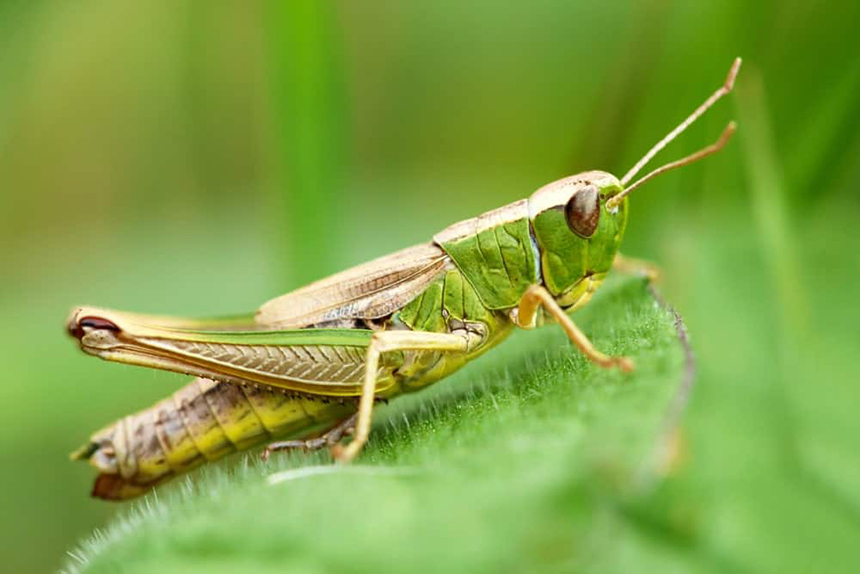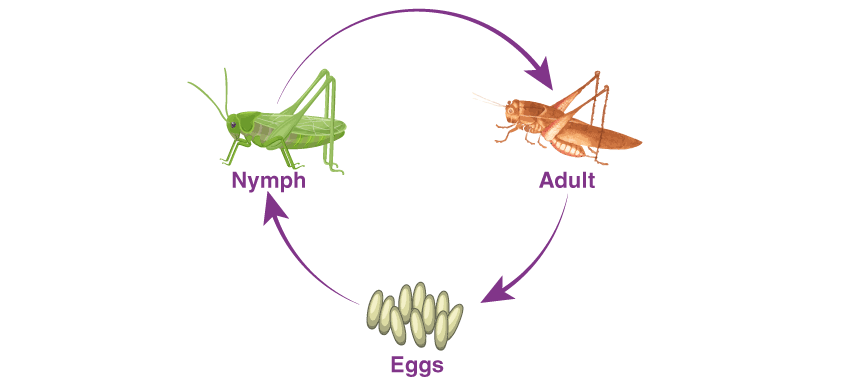

Nobody likes having bugs in their home. Flies are annoying, cockroaches are gross, and some – like grasshoppers – can be downright alarming! It’s normal to have no idea how to get rid of grasshoppers, but this article is here to help. Whether you want to know how to get rid of a grasshopper in your room or how to get rid of a grasshopper infestation in your garden, this article will cover ways to identify, prevent, and be done with grasshoppers.
It’s important to remember that grasshoppers aren’t all bad, and we’ll talk a little about the benefits of having them around. However, if your house is being plagued by, for example, the eastern lubber grasshopper, knowing how to get rid of them is crucial. Beneficial they might be, but that doesn’t mean you want them in your house!
From identification to prevention to natural solutions and repellants, as well as non-natural and chemical solutions to how to get rid of a grasshopper in your house, this article is a quick summary of everything you need to know!

The insect family known as Orthopthera contains grasshoppers, katydids, locusts, and crickets – all noisy characters associated with nighttime and plants! Identifying a grasshopper is simple so long as you can examine the insect closely enough, as they have a number of distinctive traits. After all, along with their cousins, they’re some of the largest species of insect in the world!
Grasshoppers are dark green or grey to muddy brown with bodies that are vaguely leaf-shaped. Depending on the species, they can range from half an inch to close to three inches. They have antennae, six legs, and large eyes, as well as two sets of wings. Very occasionally, these wings are brightly colored, though this doesn’t apply to most species.
The purple-and-yellow winged Florida lubber grasshopper is a little different, and when it comes to the lubber grasshopper, how to get rid of it can feel like it might be a bit different too! The good news is that, despite its bright colors, size, and prevalence, getting rid of the Florida Lubber grasshopper is no different from other grasshoppers.
Though grasshoppers are pests, they have several benefits to humanity as well, not least as a food product! Several cultures, including Mexico, China, and Indonesia, regularly eat grasshoppers that have good nutritional values. This is spreading around the world, especially in areas that are looking for alternative sources of protein. They’re very high in vitamins, including vitamin A.
Humans have interacted with grasshoppers in art, literature, and more right through from ancient to modern times.
Several grasshoppers also get rid of dead foliage, as they are strict herbivores.
Perhaps bizarrely, grasshoppers are also being used in research to detect explosives using their excellent senses of smell.
Despite their usefulness, grasshoppers can also cause a lot of damage in areas of human cultivation, like gardens and farmland. Many farmers and gardeners spend a lot of time working out how to get rid of grasshoppers in plants.
Though some species of grasshoppers are known to devastate gardens and have laid waste to gardens and farmland when left unchecked, others are significantly less likely to damage crops.
It’s clear that there’s often a reason to need to get rid of grasshoppers in a house or outside. A professional pest control expert is always the most effective, but there are several options available for you to do it yourself. In general, these are also good for those looking for eliminating crickets. If you realize that you actually have a cricket infestation, consider checking methods of getting rid of crickets.
Natural remedies and solutions for prevention and repellence or even eradication of grasshoppers. Some of the natural control methods used from ancient and through to modern times below are just as effective as they ever were!
Grasshoppers have many natural predators, though some (especially mice and rats) are pests in and of themselves. However, there are other creatures you can encourage to help control the grasshopper population. Most birds eat grasshoppers, as do frogs. Snakes and spiders also enjoy them.
Chickens love the taste of grasshoppers! In fact, they love all sorts of insects, including ants, grasshoppers, locusts, and even some beetles. The bugs often supply vitamins to the chickens too – so you can get some healthy eggs out of the deal!
When you’re growing crops, grasshoppers can be a big menace. However, regular tilling during egg season (spring and fall) will help get rid of them. The females live and lay eggs in the soil, and tilling either kills them directly or exposes them to predators. It also helps eliminate weeds.
Weeds are a natural habitat and food source for grasshoppers. Getting rid of them is a great way to encourage grasshoppers to simply go elsewhere.
Covering your crops is important to protect them from all sorts of insects, not only grasshoppers. Cheesecloth is a great tool for this, though several places sell dedicated crop covers as well. Of course, this will protect plants from new insects, but you should make sure to get rid of any existing bugs too!
Garlic is like a miracle cure for bug infestations! Many bugs hate the scent, including mayflies and mosquitoes, and grasshoppers are part of that group. While you can use crushed dry garlic, buying or creating a garlic spray to put over plants or in the house where an infestation exists is probably the most efficient way to go about it.
The spray is very easy to make. You simply add garlic to boiling water the same way that you would make tea and leave it to settle overnight. The more garlic, the stronger and more effective the spray. After a few hours or, ideally, overnight, put it in a spray bottle and you’re ready to go.
Neem oil is nature’s pesticide – literally! It’s made from the seeds of the neem tree and can be used to kill many pests, including grasshoppers. Even better, it isn’t toxic to birds, mammals (and therefore most pets), bees, or plants.
Flour can kill or at least scare off grasshoppers while they feed. It sticks to their mouths when applied to leaves, and makes it impossible for them to eat properly. Make sure to keep adding flour after rain, though!
Sometimes, natural repellents aren’t enough. In this case, the options below are great ways to prevent or kill nuisance grasshoppers.
Biological options are often the best when it comes to dealing with grasshoppers in plants, especially those that might be residing within plants, as they carry significantly less risk than chemical treatments. The most effective of these are products containing the protozoan called Nosema locustae, which specifically targets locusts, crickets, katydids, grasshoppers, and their relations.
Several chemical insecticide options exist including Safer Brand 5110-6 Insect Killing Soap or Talstar P Professional Insecticide. You should always check with your local hardware store, pest control center, or supplier if you are unsure which chemical solution is best for dealing with grasshoppers. In general, it is best to avoid chemical foggers, especially if you have pets or small children.
Boric acid is a popular and effective natural chemical that can be used to kill off several different kinds of insect and bug pests. It repels insects and, if ingested, causes their organs to shut down, killing them quickly and relatively humanely. It can be easily prepared at home using the right recipes. You can check out the Boric acid roach killer for a precise recipe.
Sprinkling boric acid can help, though you should be careful if you have pets or small children. Performing weed removal and considering applying flour to your plant leaves helps a lot, too. All of the natural solutions above, especially the garlic spray, are particularly effective in gardens too.
It may take some time for dedicated treatment to be rid of grasshoppers entirely, as they tend to be quite persistent. However, keep at it and you’ll manage!
Though beetles and grasshoppers look similar and have some behavioral and habitat similarities, they are different creatures. One of the main physical differences to look out for is that beetles don’t have wings, while grasshoppers have two pairs! Beetles also have a harder shell.
Japanese beetles can be especially confusing, but the good news is that those who are looking for how to get rid of Japanese beetles can use many of the methods described for getting rid of grasshoppers though of course there are some peculiarities. If you want to target Japanese battles, it’s worth reading what exactly helps in a fight with Japanese beetles. As always, talk to your supplier or a professional before you use any treatments for help finding a more specific product to suit your needs.
The good news is that grasshoppers are not dangerous to humans or pets. They’re strict herbivores and are not poisonous either to ingest or touch. The only health risk that grasshoppers might realistically pose is if they are consumed or handled after exposure to inorganic methods of pest control. If they do bite, there is no long-term harm, though their strong jaws may make it hurt for a short time.
Grasshoppers only eat plants and plant material. This includes leaves, dead foliage, tree bark, fruit, crops, and more. While this means they aren’t dangerous, it does mean that a large gathering of grasshoppers can quickly decimate or even destroy a garden or farmland.
Yes! Though they’re known for their hopping, the strength of the grasshopper’s two sets of wings isn’t to be looked down upon. In fact, the grasshopper’s wings are so powerful that it can even migrate long distances just by flying through the air. They also use their wings during mating and fighting!

Eggs – Eggs are laid in mid-summer deep in the soil in big sacs containing anywhere between ten and three hundred other eggs. They’re very small, shaped like grains of rice. It takes nearly ten months for the eggs to hatch, as they’re completely dormant over the winter.
Nymphs – Nymphs are born light-colored and get darker as they grow. The second they’re born, they begin to eat, which helps them work toward adulthood. In the early stages, they also don’t have wings. The wings and darker colors develop through their instars or incomplete metamorphic stages, which come with each molt. A nymphal grasshopper molts between five and ten times before it reaches adulthood. Each instar stage lasts up to two weeks or as little as a few days.
Adult – After about eleven months, the nymph is finished growing, its wings are fully grown in, and it is now an adult grasshopper. As adults, they last a few months at most, though usually, the full lifespan is around a year. During this time, the males perform ritual courtship which includes fighting over females, mating occurs, and then the females lay and bury eggs to begin again.
As you can see, grasshoppers aren’t dangerous creatures but can be a real nuisance when they are in the wrong place or their population is not carefully controlled. They can cause damage to crops and other plant life, and therefore it is important to know how to identify, understand, prevent, repel, and kill grasshoppers when necessary.
This article aimed to set you up with all the basics on how to get rid of grasshoppers, as well as teach you some more about your tiny nemesis! They are persistent creatures and, due to their flying and the way they rip through plants, they can be quite alarming to have around your garden and around the house.
When you’re getting rid of grasshoppers, err toward non-toxic and safe solutions as much as you can. Remember, it might be a little overwhelming, but with the simple solutions mentioned in this article, you’ll have the grasshopper problem under control in no time.